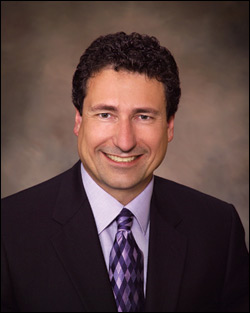Study looks at patent suit results
By: David Ziemer, [email protected]//December 10, 2010//

A new study purporting to answer the question of where attorneys should file patent cases gives high marks in opposing areas to both Wisconsin districts.
The study, published in the fall 2010 issue of AIPLA Quarterly Journal, and titled “Where to file your patent case,” is by Stanford Law Professor Mark A. Lemley. It recommends the Western District of Wisconsin as one of the best if you are seeking to enforce a patent, and the Eastern District of Wisconsin as the best if you are filing a declaratory judgment action on behalf of an accused infringer.
But local attorneys who do patent litigation say that is an oversimplification.
The study quantifies various considerations for filing in the 33 district courts nationwide that have the most filings.
Counting whether the parties holding patents “win,” neither the Eastern District nor the Western District fared high. The “Claimant Win Percentage” varied from a high of 55.1 percent in the Northern District of Texas, to a low of 11.5 percent in the Northern District of Georgia. The Eastern District of Wisconsin was second lowest of the 33 districts, at 17.1 percent, while the Western District was sixth lowest, at 24 percent.
But Lemley cautioned, “it may be the nature of the cases, the lawyers, or something else that explains part or all of this difference.” Another table demonstrated that a mere 2.8 percent of cases go to trial.
In the Western District, 7.4 percent of cases went to trial, while in the Eastern District, only 0.8 percent did.
The Western District’s high ranking rests largely on the speed with which cases are decided. The Western District ranks first in average time from filing to resolution, just 0.56 years. In the Eastern District, it is 1.21 years, the seventh slowest.
Even when a case goes to trial, the average case in the Western District does so in only 0.67 years. The second fastest district in the country, the Eastern District of Virginia, takes 0.96 years.
In contrast, in the Eastern District of Wisconsin, it takes an average of 3.51 years, the slowest of all the districts studied, save for the District of Columbia, in which no case went to trial during the entire period of the study.
In Lemley’s study, he calculates an aggregate rank for the districts, based on how the districts rank in terms of four factors: patentee win rate; percentage of cases that go to trial; the time to resolution; and the time to trial.
The Western District ranks as the fifth best district in which to enforce a patent. The Eastern District ranks dead last, which under Lemley’s methodology, makes it the best jurisdiction in which to file for declaratory judgment, if you represent an accused infringer.
Lemley concludes his study: “Accused infringers should be trying to litigate in the Eastern District of Wisconsin, the Southern District of Ohio, or the District of Columbia, none of which are currently on the radar screen of most patent lawyers. Patentees should be suing in a variety of districts, including the District of Delaware, the Eastern District of Virginia, and the Western District of Wisconsin.”
David L. DeBruin, a patent attorney in Michael Best & Friedrich‘s Milwaukee office, said it is no surprise to patent attorneys that the Western District ranks high in terms of the time it takes to resolve a case.
“The Western District has for years been considered a ‘rocket docket,'” DeBruin said in an interview. “So there is nothing too surprising with regard to that.”
But DeBruin took issue with some of Lemley’s methodology.
“For example, the focus on the percentage of wins at trial excludes settlements,” he said. DeBruin said that, in both the Western and Eastern Districts, but especially the Western District, the judges are prepared to use summary judgment in appropriate cases rather than go to trial.
“The willingness to do that prompts more settlements,” he said.
DeBruin also cited the district court’s use of Markman hearings prior to summary judgment as a major factor in prompting settlements. At a Markman hearing, the court construes the language of the patent, and decides what the patent does and doesn’t cover.
“Typically, early in the case, the court will have a hearing and decide what the patent covers,” he said. “Parties can then read the handwriting on the wall. Combine that with a willingness to do summary judgment when appropriate, and it postures well for settlement.”
DeBruin cited another factor that makes the Western District a good place to file patent litigation – the quality of the judiciary. “Historically, the Western District has been exposed to a lot of patent litigation, because both judges were interested in it, and [newly-appointed] Judge Conley is following in those footsteps,” De Bruin said. “In bigger districts, with more judges, there is less certainly regarding the quality of the judge you will get.”
DeBruin said he was skeptical of the study’s emphasis on the patent holder’s success at trial. “If I’m comfortable that I have a good case, I’m not too concerned with that statistic. I’ll look more at other factors, such as speed, and where the client and witnesses are.”
Another patent litigator from Michael Best & Friedrich, Jonathan H. Margolies, also emphasized both the quality of the judiciary, and willingness to decide cases on summary judgment.
“The judges in the Eastern District are great,” Margolies said. “They put time and thought into their opinions and have a lot of familiarity with patent law,” even if the district does not have a reputation for speed.
Margolies said the judges in the Eastern District were also inclined to decide cases on summary judgment when appropriate. “They take summary judgment seriously. Some courts just figure that if both sides have long briefs, there must be a material factual dispute somewhere.”
The citation for the study is Lemley, Mark A., Where to File Your Patent Case (October 27, 2010). Aipla Quarterly Journal, Vol. 38, No. 4, p. 1, Fall 2010; Stanford Public Law Working Paper No. 1597919. Available at SSRN: http://ssrn.com/abstract=1597919
David Ziemer can be reached at [email protected].
Legal News
- Milwaukee’s Common Council now has the most African Americans, women and openly LGBTQ members ever
- Office of School Safety Provides Behavioral and Threat Assessment Management Training Ahead of 25th Anniversary of Columbine Shooting
- Wisconsin Supreme Court to hear arguments in Democratic governor’s suit against GOP-led Legislature
- Lawsuit asks Wisconsin Supreme Court to strike down governor’s 400-year veto
- Wisconsin man pleads not guilty to neglect in disappearance of boy
- ACS Selects University of Wisconsin Law School’s Miriam Seifter for 2024 Ruth Bader Ginsburg Scholar Award
- People with disabilities sue in Wisconsin over lack of electronic absentee ballots
- Wisconsin Republicans ignore governor’s call to spend $125M to combat ‘forever chemicals’
- Native American voices are finally factoring into energy projects
- Steven Avery prosecutor Ken Kratz admits ‘mistakes were made’
- Colombian national extradited to Milwaukee faces International narcotics-trafficking conspiracy charge
- MPD: Milwaukee homicides down nearly 40 percent compared to last year
WLJ People
- Power 30 Personal Injury Attorneys – Russell Nicolet
- Power 30 Personal Injury Attorneys – Benjamin Nicolet
- Power 30 Personal Injury Attorneys – Dustin T. Woehl
- Power 30 Personal Injury Attorneys – Katherine Metzger
- Power 30 Personal Injury Attorneys – Joseph Ryan
- Power 30 Personal Injury Attorneys – James M. Ryan
- Power 30 Personal Injury Attorneys – Dana Wachs
- Power 30 Personal Injury Attorneys – Mark L. Thomsen
- Power 30 Personal Injury Attorneys – Matthew Lein
- Power 30 Personal Injury Attorneys – Jeffrey A. Pitman
- Power 30 Personal Injury Attorneys – William Pemberton
- Power 30 Personal Injury Attorneys – Howard S. Sicula











